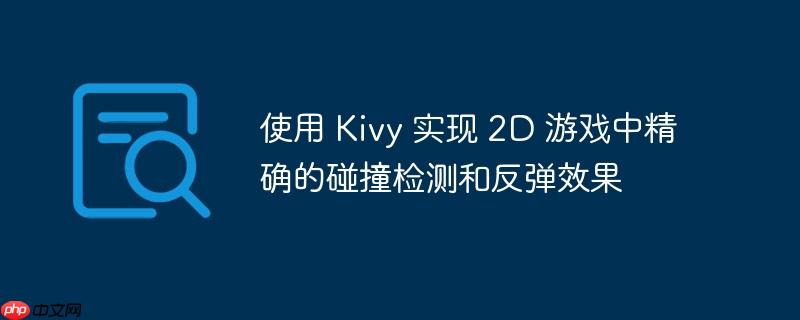
本文将指导你如何在 Kivy 框架中实现 2D 游戏中球体和玩家之间的碰撞检测和反弹效果。我们将利用 collide_widget() 方法检测碰撞,并根据碰撞位置计算反弹方向,从而实现更真实的物理交互。通过本文的学习,你将掌握 Kivy 中基本的碰撞处理方法,并能将其应用到自己的游戏中。
Kivy 的 Widget 类提供了一个非常有用的方法:collide_widget()。该方法用于检测两个 Widget 是否发生碰撞。如果两个 Widget 的矩形区域重叠,则认为发生了碰撞,该方法返回 True,否则返回 False。
仅仅检测到碰撞是不够的,我们还需要根据碰撞发生的位置来决定反弹的方向。以下代码展示了如何在 Ball 类中实现一个 check_collision 方法,用于检测球体和玩家的碰撞,并根据碰撞位置调整球体的速度:
def check_collision(self, player):
if self.collide_widget(player):
if self.y <= player.top and self.center_y > player.top and self.center_x < player.right and self.center_x > player.x:
# bounce off top of player
self.velocity_y *= -self.bounce_factor
self.y = player.top
elif self.top >= player.y and self.center_y < player.y and self.center_x < player.right and self.center_x > player.x:
# bounce off bottom of player
self.velocity_y *= -self.bounce_factor
self.top = player.y
elif self.x <= player.right and self.center_x > player.right and self.center_y < player.top and self.center_y > player.y:
# bounce off right side of player
self.velocity_x *= -self.bounce_factor
self.x = player.right
elif self.right >= player.x and self.center_x < player.x and self.center_y < player.top and self.center_y > player.y:
# bounce off left side of player
self.velocity_x *= -self.bounce_factor
self.right = player.x
else:
print('\tdid not calulate collision:')
print('\t\tball:', self.pos, self.center, self.top, self.right)
print('\t\tplayer:', player.pos, player.center, player.top, player.right)代码解释:
将 check_collision 方法添加到 Ball 类后,需要在游戏循环的 update 方法中调用它:
class GameScreen(Widget):
# ... 其他代码 ...
def update(self, dt):
self.ball.move()
self.player.move()
# 添加碰撞检测
self.ball.check_collision(self.player)
if (self.ball.y < 0) or (self.ball.top > self.height):
self.ball.velocity_y *= -1
if (self.ball.x < 0) or (self.ball.right > self.width):
self.ball.velocity_x *= -1
if self.player.top >= self.height:
self.player.velocity_y *= 0
self.player.y = self.height - self.player.height
if self.player.x < 0:
self.player.velocity_x *= 0
self.player.x = 0
if self.player.right > self.width:
self.player.velocity_x *= 0
self.player.x = self.width - self.player.width在 GameScreen 类的 update 方法中,在 self.ball.move() 和 self.player.move() 之后,调用 self.ball.check_collision(self.player) 方法,即可实现碰撞检测和反弹效果。
本文介绍了如何在 Kivy 框架中实现 2D 游戏中的碰撞检测和反弹效果。通过使用 collide_widget() 方法和自定义的反弹逻辑,可以实现基本的物理交互。希望本文能够帮助你更好地理解 Kivy 中的碰撞处理,并将其应用到你的游戏中。记住,游戏开发是一个不断迭代的过程,需要不断尝试和改进,才能创造出更好的游戏体验。
以上就是使用 Kivy 实现 2D 游戏中精确的碰撞检测和反弹效果的详细内容,更多请关注php中文网其它相关文章!

每个人都需要一台速度更快、更稳定的 PC。随着时间的推移,垃圾文件、旧注册表数据和不必要的后台进程会占用资源并降低性能。幸运的是,许多工具可以让 Windows 保持平稳运行。

Copyright 2014-2025 https://www.php.cn/ All Rights Reserved | php.cn | 湘ICP备2023035733号